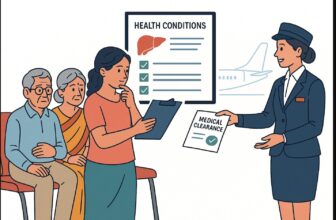India is home to one of the world’s largest populations of people with diabetes, often referred to as the “Diabetes Capital of the World.” According to the ICMR-INDIAB 2023 report, India has over 100 million adults living with diabetes and another 130 million with pre-diabetes. What makes this alarming is not just the absolute numbers, but also the early onset of the disease, the rapid spread to semi-urban and rural populations, and the rising incidence in young adults and children.
Diabetes in India is not caused by sugar alone. Instead, it emerges from a complex mix of genetics, early life nutrition, diet composition, stress, lifestyle changes, and environmental triggers. This list explains 15 science-backed reasons why Indians are more vulnerable to diabetes than many other populations.
1. South Asian Genes That Amplify Insulin Resistance
South Asians have been found to have inherently higher insulin resistance compared to European populations. This means their bodies need more insulin to manage the same amount of glucose. If a close relative has diabetes, the risk increases sharply. Genetic studies, including those published in the Indian Journal of Endocrinology and Metabolism, confirm this hereditary vulnerability.
2. The “Thin-Fat” Body Type Seen in Many Indians
A unique South Asian trait is the so-called “thin-fat” body type: people may look lean by body mass index (BMI) but have higher levels of visceral fat around the abdomen and internal organs. This hidden fat increases insulin resistance and cardiovascular risks even when weight seems “normal.”
3. Desk Jobs, Long Commutes, and Sedentary Urban Living
With rapid urbanization, desk jobs, long commutes, and excessive screen time dominate daily routines. Surveys by the Indian Council of Medical Research (ICMR) show that fewer than 10% of urban Indians engage in recommended levels of physical activity. Sedentary behaviour directly contributes to obesity, insulin resistance, and early diabetes onset.
4. Heavy Dependence on White Rice and Wheat in Indian Diets
The Indian diet traditionally includes staples such as polished rice, wheat flour (maida), and potatoes, foods that have a high glycemic index. These raise blood sugar levels quickly. Overdependence on refined carbs, combined with declining intake of protein and fibre, worsens diabetes risk.
5. Packaged Snacks, Sugary Tea, and Festival Sweets Driving Sugar Intake
India is the largest consumer of sugar globally. Beyond sugar in tea and sweets, there is also rising consumption of ultra-processed foods: packaged snacks, sugary drinks, and ready-to-eat meals. These foods promote weight gain and increase blood sugar spikes. Market studies show that India’s packaged food market is expanding at nearly 12% CAGR, making processed food a major driver of lifestyle diseases.
6. Low-Birth-Weight Babies Growing Into Overfed Adults
Many Indian children experience undernutrition early in life, leading to low birth weight and poor muscle mass. Later, when exposed to calorie-rich diets, their bodies respond poorly. This mismatch, explained under the “thrifty phenotype hypothesis,” creates a higher risk of diabetes in adulthood. Research from The Lancet highlights that this early nutritional disadvantage persists across generations.
7. Expanding Waistlines Despite “Normal” Weight in Indians
For Indians, even modest weight gain concentrated in the abdomen is dangerous. Waist-to-hip ratio is a stronger predictor of diabetes risk than BMI. According to the National Family Health Survey (NFHS-5), over 50% of urban Indian adults show signs of central obesity, making it a significant contributor.
8. Late-Night Work Hours, Stressful Exams, and Poor Sleep in Indian Cities
Sleep disorders and chronic stress raise cortisol levels, which interfere with insulin function. In Indian cities, where long work hours and irregular shifts are common, studies show that more than 30% of professionals sleep less than 6 hours a night. Stress from competitive education systems and corporate jobs adds to this hidden risk.
9. Vitamin D Deficiency Despite Abundant Sunlight in India
Despite abundant sunlight, 70-90% of urban Indians are Vitamin D deficient due to indoor lifestyles, pollution, and limited outdoor exposure. Vitamin D plays a role in insulin sensitivity, and deficiency has been linked to a higher incidence of diabetes in South Asian populations.
10. Air Pollution in Indian Metros Worsening Metabolic Health
Air pollution has been associated with chronic inflammation and metabolic disorders. A 2020 study in Diabetes Care linked long-term exposure to particulate matter (PM2.5) with a significant increase in diabetes risk. India, home to some of the world’s most polluted cities, faces this additional environmental trigger.
11. Early Onset of Diabetes in Indian
Unlike Western populations where type 2 diabetes often develops after 50, Indians are developing it as early as their 30s and 40s. This means longer exposure to complications like kidney disease, neuropathy, and heart problems. Early onset also affects workforce productivity and healthcare costs.
12. Cultural Food Habits: Fried Snacks and Carb-Heavy Feasts
Food plays a central role in Indian social and cultural life. High-calorie festive sweets, deep-fried snacks, and frequent carbohydrate-heavy meals add to the burden. Late-night eating, a common practice, further disrupts glucose metabolism. This cultural relationship with food makes lifestyle modification more challenging.
13. Low Awareness and Late Diagnosis
Nearly 50% of Indians with diabetes remain undiagnosed, according to ICMR estimates. Many only discover the condition when complications such as vision loss, kidney damage, or nerve pain have already developed. Limited screening programs, low awareness in rural areas, and stigma contribute to delayed diagnosis.
14. Rising Gestational Diabetes Rates Among Indian Women
India has one of the highest rates of gestational diabetes mellitus (GDM), affecting 10-14% of pregnancies. Women with GDM have a much higher chance of developing type 2 diabetes later, and their children are also at increased risk. This creates a multi-generational cycle of vulnerability.
15. Diabetes Rising Fastest in Semi-Urban and Rural India
Diabetes is no longer confined to cities. The fastest rise in prevalence is now seen in semi-urban and rural areas, where traditional diets are being replaced by packaged foods and physical labor is declining. This epidemiological shift shows that diabetes is spreading to populations once considered “low risk.”
Quick Reference Table: 15 Reasons Indians Are More Prone to Diabetes
| Reason | Scientific Explanation | India-Specific Evidence |
|---|---|---|
| Genetic Susceptibility | South Asians have naturally higher insulin resistance | Indian Journal of Endocrinology and Metabolism shows strong family history risk |
| Thin-Fat Phenotype | Lean BMI but high visceral fat raises diabetes risk | Documented in multiple South Asian cohort studies (The Lancet) |
| Urban Sedentary Lifestyle | Lack of physical activity worsens insulin resistance | ICMR surveys: <10% of urban Indians meet activity guidelines |
| High-Carbohydrate Diet | Polished rice/wheat have high glycemic index | NFHS data: majority of calorie intake from refined carbs |
| Sugar & Processed Foods | Ultra-processed snacks and sugary drinks spike glucose | India is world’s largest sugar consumer; packaged food market growing ~12% CAGR |
| Childhood Malnutrition → Adult Overnutrition | Early undernutrition followed by overnutrition increases lifetime risk | The Lancet South Asia studies confirm this “thrifty phenotype” |
| Abdominal Obesity | Central obesity is stronger predictor than BMI | NFHS-5: >50% of urban adults show abdominal obesity |
| Sleep Deprivation & Stress | High cortisol disrupts insulin control | Surveys: 30% of Indian professionals sleep <6 hrs/night |
| Vitamin D Deficiency | Low Vitamin D reduces insulin sensitivity | 70–90% of urban Indians deficient despite sunlight |
| Environmental Pollution | PM2.5 exposure linked to metabolic disorders | Diabetes Care (2020): strong association in polluted regions |
| Early Onset of Diabetes | Indians develop type 2 diabetes ~10 years earlier than West | ICMR: many diagnosed in 30s–40s, not 50s–60s |
| Cultural Food Practices | Frequent sweets, fried snacks, late-night meals increase risk | Festive and social food habits make moderation harder |
| Low Awareness & Late Diagnosis | Many discover diabetes only after complications | ICMR: ~50% of Indians with diabetes remain undiagnosed |
| Gestational Diabetes (GDM) | Pregnancy diabetes increases lifelong risk for mother & child | 10–14% of pregnancies in India affected (one of world’s highest rates) |
| Rural-to-Urban Lifestyle Transition | Processed foods + reduced physical labour driving rural diabetes | Recent ICMR-INDIAB surveys show fastest rise in semi-urban/rural India |
Final Takeaway – Beyond Just Sugar
India’s diabetes epidemic is the result of multiple interacting factors: genetic predisposition, hidden fat distribution, high-carb diets, sedentary lifestyles, poor sleep, nutritional imbalances, and environmental stressors. Sugar is only part of the story.
To tackle this challenge, India needs:
- Early screening and awareness, especially in rural and semi-urban populations.
- Dietary interventions, focusing on reducing refined carbs and processed foods while increasing protein and fibre.
- Lifestyle changes, including regular exercise, adequate sleep, and stress management.
- Policy-level action, such as nutrition education, food labelling, and tackling air pollution.
Unless these steps are taken, India’s already high burden of diabetes will continue to rise, affecting not only health outcomes but also economic productivity and healthcare systems.
References:
- https://www.thelancet.com/pdfs/journals/landia/PIIS2213-8587(23)00119-5.pdf
- https://pubmed.ncbi.nlm.nih.gov/37301218
- https://www.who.int/india/health-topics/noncommunicable-diseases
- https://www.thelancet.com/series-do/diabetes-in-south-asia
- https://pmc.ncbi.nlm.nih.gov/articles/PMC9438889




